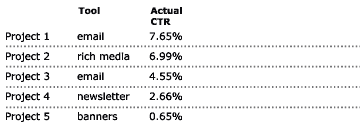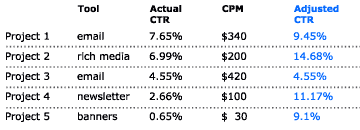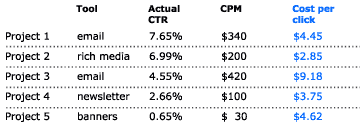Comparing the performance of online marketing projects is anything but straight forward. In fact, the process presents several traps that lead marketing managers to make the wrong decisions by making inaccurate observations about campaign results.
The problem is so prevalent that few marketing managers actually know which projects generate the best results even when presented with the click-through rates for each project. The problem becomes quite serious as more and more companies execute fully-integrated online marketing campaigns. Unfortunately, most Internet campaigns fall short of achieving their goals because they are based on the wrong set of data and assumptions.
The good news is that avoiding the comparison traps is very easy. By taking some precautions before comparing campaign results, you will be able to gain a substantial advantage over your competitors. First, you will actually know what really works and what does not work before investing one dollar online. Second, believe it or not, the people who sell you online advertising opportunities are making the same mistakes advertisers make. In short, they do not know how well the solutions they offer really perform. As a result, they offer some of the best Internet tools at a great discount.
Adjusted click-through rates are not just another clever concept designed to give life back to Internet marketing. On the contrary, adjusted click-through rates define a reliable framework for assessing the viability of specific online tools as solid marketing solutions. Once rates have been adjusted, a different picture emerges, often dramatically changing the performance ranking of the online projects. Quickly, online tools that have become the darlings of marketing managers because they have consistently produced better results lose their appeal while tools that were once categorized as ineffective are given a second chance by showing strong results.
The concept is best illustrated by a simple example.
True or False - The following table accurately ranks the performance of the online projects from best to worst.

If you answered that you do not have enough information to make a decision, you are correct. Without taking into account the cost per thousand for each project, comparing click-through rates is completely useless.

The addition of the CPM data leads to a more complete picture. However, in its present form the information is still difficult to compare. By introducing adjusted click-through rates, we can present information we can act on. Adjusted rates simply take into account the CPM of each project, using the highest CPM as the basis for the comparison.

The accuracy of the new ranking can be demonstrated by measuring the cost per click for each project. The lower the cost per click, the better the project performance. Hence, the best project will have the highest adjusted rate and the lowest cost per click.
Let's assume that we have spent $1000 on each project. Based on the CPM and actual click-through rates, project 1 generated 225 clicks ($1000/$340)x1000 x 7.65%). The cost per click: $4.45.
Similarly, we get :

When comparing the ranking resulting from the adjustment of click-through rates to the ranking based on cost per click, we can see that they are identical.

Unfortunately, the majority of marketing managers still base their decisions by comparing response rates based on actual click-through rates.
Astute online marketing managers will quickly point out that it is necessary to take the comparison activities a step further by also comparing actual sales generated by each project. Clicks and visitors are just part of the equation. For most companies, the success of online marketing endeavors is ultimately measured by their additions to the bottom line. In such cases, it is critical to incorporate sales figures into the mix to develop optimal online marketing strategies.